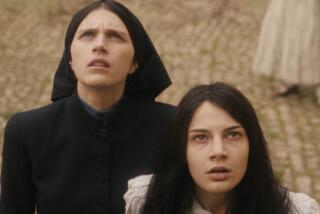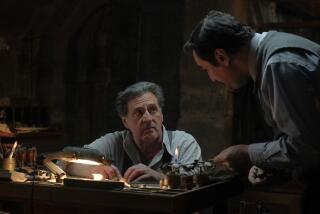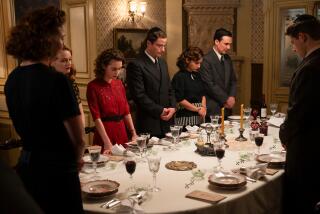‘Beloved Sisters’: German period romance a tough sell even there
The new German film “Beloved Sisters,” which opens Friday in Los Angeles, has not only received critical acclaim but is also that country’s official submission in the foreign language Oscar derby.
Yet the tantalizing and thought-provoking period drama chronicling a purported romance involving renowned 18th century poet and playwright Friedrich Schiller and two aristocratic sisters was a hard-sell in its homeland.
“It was such a fragile project,” noted writer-director Dominik Graf (“The Red Cockatoo”), in an email interview. “At each stage, it was attacked by financiers, by the German film industry [which said], ‘Why on earth this? Complicated feelings of complicated upper class people from the past! Nothing for a wider audience!’”
The main reason the 170-minute film eventually got made was the perseverance of producer Uschi Reich, who, according to Graf, “fought a long fight.”
That fight went on for almost a decade. While making a movie on the playwright for German television in 2004, Reich learned about the purported ménage à trois among Schiller (Florian Stetter) and the two Von Lengefeld sisters — Caroline (Hannah Herzsprung), who had been forced into a loveless marriage to help secure the family’s diminishing finances, and her younger sister Charlotte (Henriette Confurius).
It was Charlotte who first met Schiller in 1787, when she was sent to live with her godmother in hopes of her securing a husband. Schiller and Charlotte eventually married so that the the relationship could continue without scrutiny. But when Caroline herself began to write, the relationships’ dynamic changed.
Caroline, who published her first novel, “Agnes von Lilien,” in the 1790s, never mentioned a romantic entanglement with Schiller in her 1830 biography of the writer, “Schiller’s Life.”
“After Schiller died, Caroline destroyed almost every letter they wrote to each other,” said Herzsprung. “She didn’t want anybody to know about the love story between them.”
But there has been a lot of conjecture about the trio’s relationship, including a novel imagining their unconventional romance.
It was Reich, said Graf, who brought the project to him. “I come from a good bourgeois-cultural background, and [the story was] completely new. I started to research, read tons of books, so I could write the script.”
Graf said he was immediately caught up by “the atmosphere of the story, the love and the intimacy of the three characters and their will to find a well-guarded place for their feelings. Everything they did and planned was tender and free willing and devoted to each other.”
But the plan for Charlotte and Schiller to marry so that Caroline could join them worked only for a short time, Graf said. “But then, over the years, time itself, the daily routine became the enemy of their utopia.”
Herzsprung, who found Graf’s script “such a page turner,” also did her own research extensively, much of it at the Schiller National Museum in Germany. “You find original letters from that time,” she said. “There were many portraits of the two sisters. I just love to work with pictures when I start to create the characters.”
The paintings of 19th century German artist Georg Friedrich Kersting influenced the film’s realistic look. “His style seemed to have the artistic modesty that we tried to achieve for this story,” Graf said. “There is no overwhelming drama-making with fast cameras, but a more restrained way of storytelling, letting the words be the center of the film.”
Twitter: @mymackie
More to Read
Only good movies
Get the Indie Focus newsletter, Mark Olsen's weekly guide to the world of cinema.
You may occasionally receive promotional content from the Los Angeles Times.







